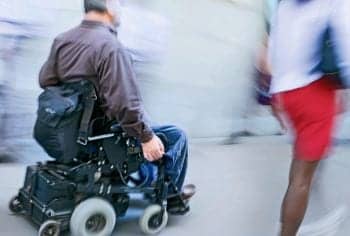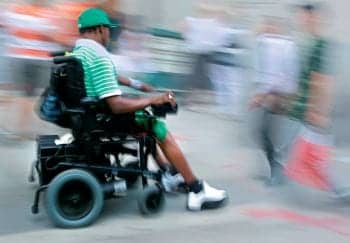
When performing an evaluation with a user who has a long history of operating power mobility devices, it is not uncommon for one of the questions asked during the evaluation to be “How fast does the wheelchair go?”
Matching the correct power base to a consumer is one of the most challenging and critical tasks of a clinician in the field of seating and positioning. The power base choice can make or break a consumer’s satisfaction with the final product.
During a wheelchair evaluation, a great deal of information must be gathered from the consumer and that person should be educated about the best available options. When it comes to the power base, many of the options offered come down to the consumer’s personal preference. The following are several of the most important factors to consider when educating the consumer about power base choices.
Drive Wheel Configuration—There are three main drive wheel configurations: front-wheel drive, mid-wheel drive, and rear-wheel drive. Each of these configurations offers specific benefits.
Front-Wheel Drive: Front-wheel drive allows for making nice tight corners from narrow corridors. It also climbs over obstacles very well; since the drive wheels are up front, the wheelchair is able to pull itself up and over an obstacle rather than having to push caster wheels over the obstacle. Furthermore, with the drive wheels located in front and no front caster wheels, there tends to be more space for positioning of contracted or tight lower extremities.
Mid-Wheel Drive: Mid-wheel drive allows the user to maneuver in tight spaces easily. The turning radius of this type of wheelchair allows users to turn within the footprint of the wheelchair itself, so 360-degree turns are more easily achieved. This type of drive wheel configuration is often very intuitive to operate for a user who was previously ambulatory. These wheelchairs can handle many different indoor and outdoor environments because of how the wheels are configured. They typically hold their line a little better moving across grades because the drive wheel is in the center of the wheelchair, so the casters do not have as much tendency to trail downhill.
Rear-Wheel Drive: Rear-wheel drive tends to be chosen by those who want to drive at faster speeds or who have always used a rear-wheel drive configuration wheelchair. These designs handle outdoor terrain very well and usually have a stable platform. They also work well with alternative controls. Typically, if a user has always operated rear-wheel drive devices, it may be wise to consider staying with this configuration as the transition from rear-wheel drive to other drive wheel configurations can be very difficult.

Before moving forward with a power base, it is important to ensure that all aspects of power positioning have been decided, since this will heavily influence the power base choice.
Suspension: After drive wheel configuration has been determined, the evaluating team must educate the consumer about the suspension of the base. There are many factors that influence how a wheelchair performs, and suspension is a factor that can make or break a wheelchair’s performance. The choice of using a power base with suspension typically comes down to what the user is accustomed to. If the consumer has always used a power base without suspension, there may be little concern about suspension.
Wheelchair suspension can dampen vibration, which can affect the comfort of the user. Depending on the drive wheel configuration, suspension can affect how the wheelchair handles different obstacles. A good example can be noted in the performance of mid-wheel drive. Mid-wheel drive will require the front caster wheels to lift up and over an obstacle while allowing the drive wheel to maintain contact with the ground in order to provide the power needed to climb over the obstacle. This maneuver in a mid-wheel drive power wheelchair requires suspension to be utilized in the system. Suspension also can be used in a power base to improve how the user feels in the wheelchair. If the power base has suspension, it can absorb some of the impact on the power base while driving through different environments. This can help the user remain well positioned and comfortable in the wheelchair since they are not affected as much by the force of the terrain on the wheelchair.
A user who has spasticity can benefit from additional suspension within the power base. The added suspension can decrease the effects of the environment and terrain on the user’s spasticity by reducing how the contact is felt. For individuals who experience pain, suspension can help alleviate some of the pain that might be felt moving over surfaces that may jar the body and cause additional pain. Suspension also may affect where the seating needs to be located on the power base. This is because for the suspension to work correctly, the user’s weight has to be distributed properly on the power base. It also can assist with the stability an individual feels when seated in a power base and driving over rougher surfaces. In considering an individual who has a high level spinal cord injury, that person is going to want stability and suspension that can assist with providing this type of benefit when driving over varied terrain.
Shock absorbers offer another way of providing suspension within a power base. When utilizing shock absorbers, closer attention must be given to the user, which will influence how well a shock absorber functions.
Speed and Power of Motors: When performing an evaluation with a user who has a long history of operating power mobility devices, it is not uncommon for one of the questions asked during the evaluation to be “How fast does the wheelchair go?” Typical speeds found among technologies throughout the industry are 4.5 mph up to 8 mph. The assumption that speed does not significantly impact the user’s life could not be more incorrect.
I once worked with a user who frequently traveled between towns to visit friends. If we supplied this individual with a different, slower speed motor than to what he was accustomed, that decision would have resulted in great dissatisfaction. Also, getting across intersections is a common reason consumers want a faster motor package. People driving cars don’t always see someone in a wheelchair when crossing a busy intersection; in this case, the primary objective is to move the user out of the intersection quickly.
The power of a motor also can have an effect on handling different terrain around the home and community. The power of a motor will impact the wheelchair’s ability to climb steep driveways or roads, which are commonplace in more rural areas. Speed and power of a motor can have a significant effect on the wheelchair choice the consumer makes.
Electronics: The electronics of the power base are going to directly affect how the wheelchair handles, how it can be programmed, and whether the power base can meet the specialized needs of the user.
There are two main types of electronics in the complex rehab industry: expandable and nonexpandable. The nonexpandable electronics do not allow for a specialty control to be added onto the system later. If a specialty control is needed due to a progression of illness, new electronics would need to be provided on the power base. The nonexpandable electronics offer programming of driving parameters, but since specialty controls cannot be added, the programming typically ends there. Being able to program driving parameters allows a clinician to dial in the way the wheelchair handles, how it feels to the user, and how effective and safe the user feels when driving the power base. Nonexpandable electronics also often offer control of two or fewer power positioning components, such as tilt and recline or tilt and power seat elevation, etc. This allows the user to operate the joystick to control the power seating rather than having a separate switch to control power seat functions.
The expandable electronics allow the evaluating team peace of mind that they can dial in the electronics to meet the user’s needs now, and if the consumer changes in the future, the team will be able to add components later to allow the person to continue to drive the power base. The components referred to are specialty controls such as a head array, or sip and puff, or alternative controls. What the team has to consider is not only if those controls can be added later, but also how programmable the system is so it may be dialed in to meet the user’s needs.
Power Positioning Options: Another big question will be “Does the consumer require power positioning on the power base to meet medical needs?” The power base options are typically power tilt, power recline, power elevating legrests, or power seat elevation. The user needs to be educated about the benefits of each and how they will impact the seat-to-floor height on the power base and which power bases can receive a power positioning system. Access to the power positioning system also will impact what type of electronics will be the correct choice for the user. So before moving forward with a power base, it is important to ensure that all aspects of power positioning have been decided, since this will heavily influence the power base choice.
Based on what has been reviewed here, there are many factors included in educating the user and assisting in making a correct choice about power base. As members of the evaluating team, it is the responsibility of clinicians to ensure the user is educated in all aspects of a power base to properly choose a product that best suits their needs. The proper choice of power base will ultimately lead to a satisfied user—a goal for which all clinicians should strive.
Jay Doherty, OTR, ATP/SMS, has more than 16 years of clinical experience, and a keen understanding of seating and positioning requirements and equipment. As the Clinical Education Manager for Pride Mobility Products Corporation/Quantum Rehab, Doherty oversees the development of complex rehabilitation education programs and speaks to rehabilitation facilities and equipment providers from a clinical perspective. For more information, contact .





